1994 BUICK REGAL engine overheat
[x] Cancel search: engine overheatPage 191 of 308
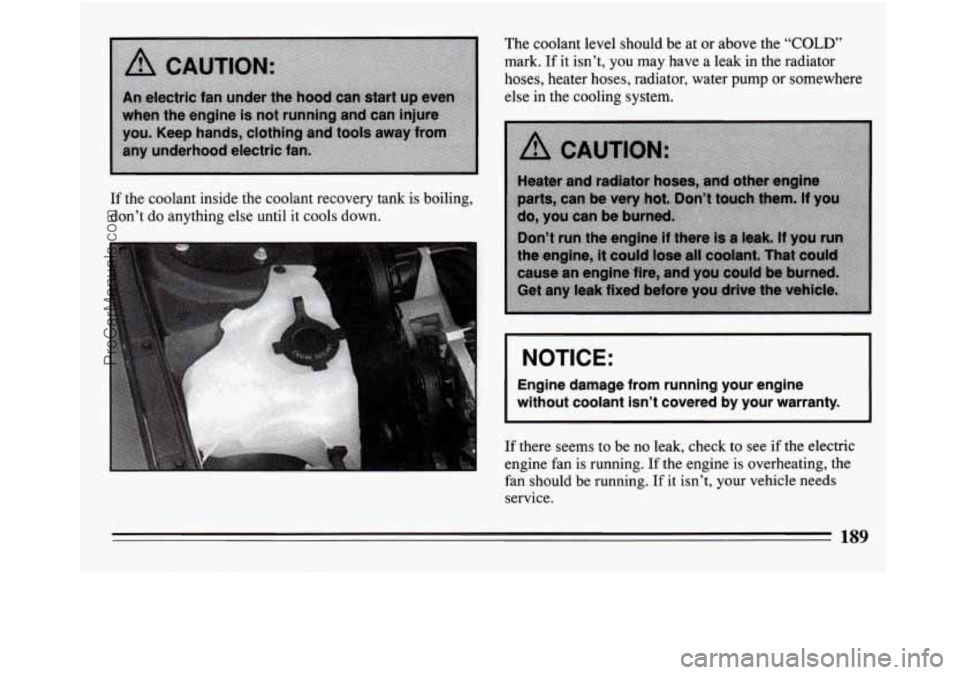
If the coolant inside the coolant recovery tank is boiling,
don’t do anything else until it cools down. The coolant level should be
at or above the
“COLD’
mark. If it isn’t, you may have a leak in the radiator
hoses, heater hoses, radiator, water pump or somewhere
else in the cooling system.
I NOTICE:
I
Engine damage from running your engine
without
coolant isn’t covered by your warranty. I
If there seems to be no leak, check to see if the electric
engine fan is running.
If the engine is overheating, the
fan should be running.
If it isn’t, your vehicle needs
service.
ProCarManuals.com
Page 193 of 308
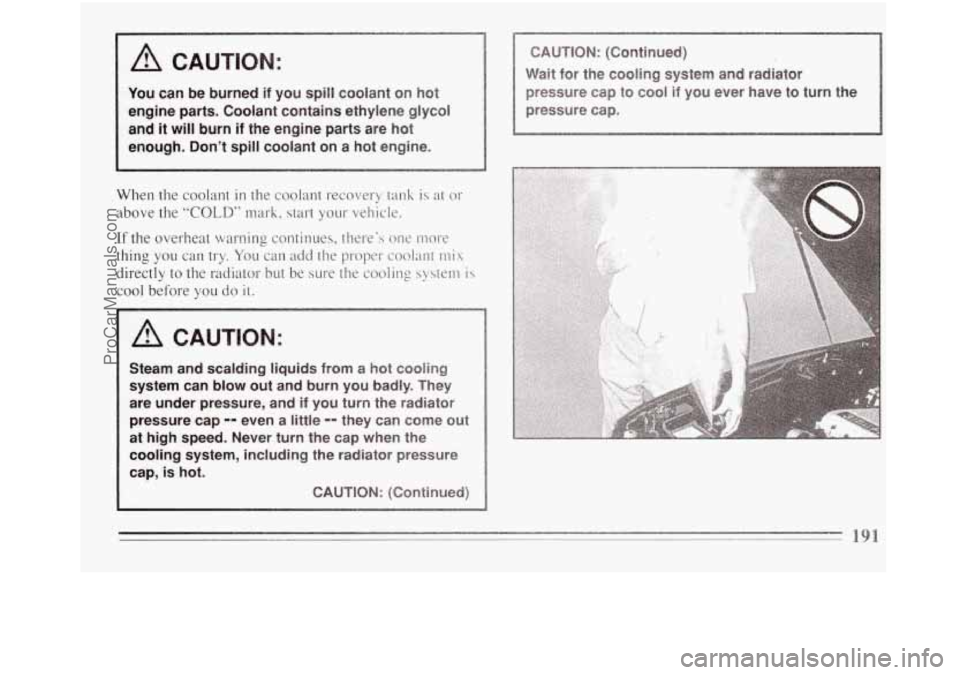
I A CAUTION:
You can be burned if you spill coolant on hot
engine parts. Coolant contains ethylene glycol
and
it will burn if the engine parts are hot
enough, Don’t spill coolant on a hot engine.
When the coolant in the coolant recovery tank is at or
above the
“COLD” mark, start your vehicle.
If the overheat warning continues, there’s one more
thing you can try.
You can add the proper coolant mix
directly to the radiator but be sure the cooling system is
cool before you do it.
A CAUTION:
Steam and scalding liquids from a hot cooling
system can blow out and
burn you badly. They
are under pressure,
and if you turn the radiator
pressure cap
-- even a fittle -- they can come out
at
high speed. Never turn the cap when the
cooling system, including the radiator pressure
cap, is
hot.
CAUTION: (Continued)
CAUTION: (Continued)
Wait for
the cooling system and radiator
pressure cap to cool
if you ever have to turn the
pressure cap.
d
I
191
ProCarManuals.com
Page 194 of 308
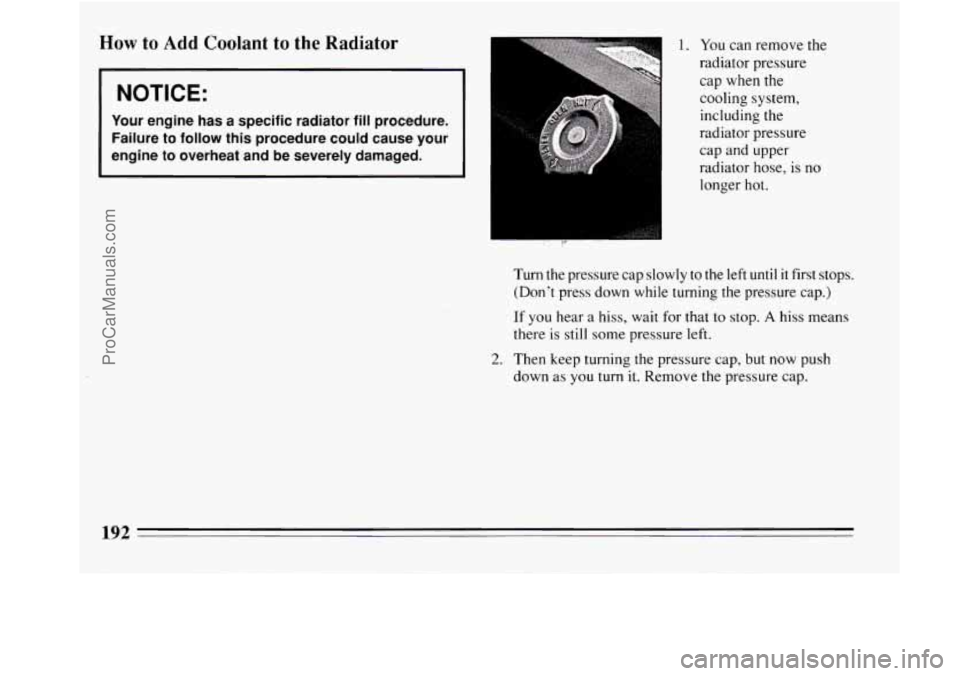
How to Add Coolant to the Radiator
NOTICE:
Your engine has a specific radiator fill procedure.
Failure to follow this procedure could cause your
engine to overheat and
be severely damaged.
. ..,
1. You can remove the
radiator pressure cap when
the
cooling system,
including the
radiator pressure
cap and upper
radiator hose, is no
longer hot.
2.
Turn the pressure cap slowly to the left until it first stops.
(Don’t press down while turning the pressure cap.)
If you hear a hiss, wait for that to stop.
A hiss means
there
is still some pressure left.
Then keep turning the pressure cap, but now push
down as you turn
it. Remove the pressure cap.
192
ProCarManuals.com
Page 225 of 308
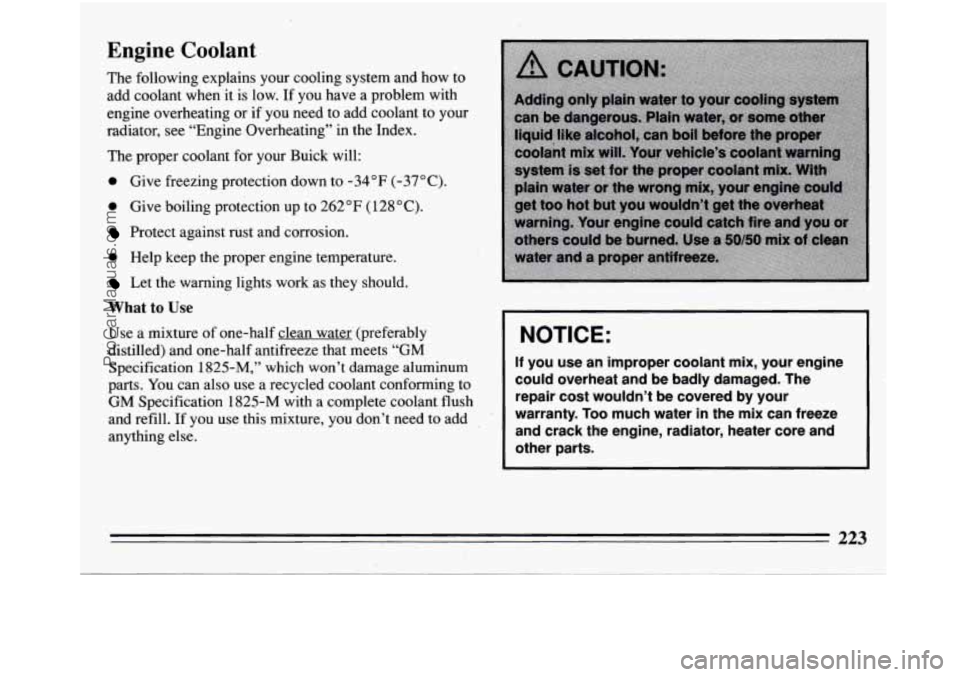
Engine Coolant
The following explains your cooling system and how to
add coolant when it is low. If you have a problem with
engine overheating or if you need to add coolant to your
radiator, see “Engine Overheating” in the Index.
The proper coolant for your Buick will:
0 Give freezing protection down to -34°F (-37°C).
0 Give boiling protection up to 262°F (128°C).
Protect against rust and corrosion.
0 Help keep the proper engine temperature.
Let the warning lights work as they should.
What to Use
Use a mixture of one-half clean water (preferably
distilled) and one-half antifreeze that meets “GM Specification
1825-M,” which won’t damage aluminum
parts. You can also use a recycled coolant conforming to
GM Specification 1825-M with a complete coolant flush
and refill.
If you use this mixture, you don’t need to add
anything else.
NOTICE:
If you use an improper coolant mix, your engine
could overheat and be badly damaged. The repair cost wouldn’t be covered by your
warranty. Too much water in the mix can freeze
‘and crack the engine, radiator, heater core and other parts.
223
ProCarManuals.com
Page 226 of 308

Adding Coolant
The coolant recovery tank is located at the left of the
engine compartment.
To Check Coolant
When your engine is cold, the coolant level should be at
“COLD” or a little higher. When your engine is warm,
the level should be up to
“HOT” or a little higher.
LOW
COOLANT
If this light comes on,
it means you’re low on
engine coolant.
To Add Coolant
If you need more coolant, add the proper mix at the
coolant recovery tank.
If the coolant recovery tank is completely empty, add
coolant to the radiator. (See “Engine Overheating” in the
Index.)
224
ProCarManuals.com
Page 227 of 308

A CAUTION:
Turning the radiator pressure cap when the
engine
and radiator are hot can allow steam and
scalding liquids
to blow out and burn you badly.
With the coolant recovery tank, you will almost
never have
to add coolant at the radiator. Never
turn the radiator pressure cap -- even a little --
when the engine and radiator are hot.
Add coolant mix at the recovery tank, but be careful not
to spill it.
A CAUTION:
You can be burned if you spifl coolant on hot
engine parts. Coolant contains ethylene glycol,
and
it will burn if the engine parts are hot
enough. Don’t spill coolant on a hot engine.
Radiator Pressure Cap
NOTICE:
Your radiator cap is a 15 psi (1 05 kPa)
pressure-type cap and must be tightly installed
to prevent coolant
loss and possible engine
damage from overheating. Be sure the arrows on
the cap line up with the overflow tube on the
radiator filler neck.
When you replace your radiator pressure cap, an AC@
cap
is recommended.
Thermostat
Engine coolant temperature is controlled by a thermostat
in the engine coolant system. The thermostat stops the
flow of coolant through the radiator until the coolant
reaches a preset temperature.
When
you replace your thermostat, an AC@ thermostat
is recommended.
225
ProCarManuals.com
Page 297 of 308
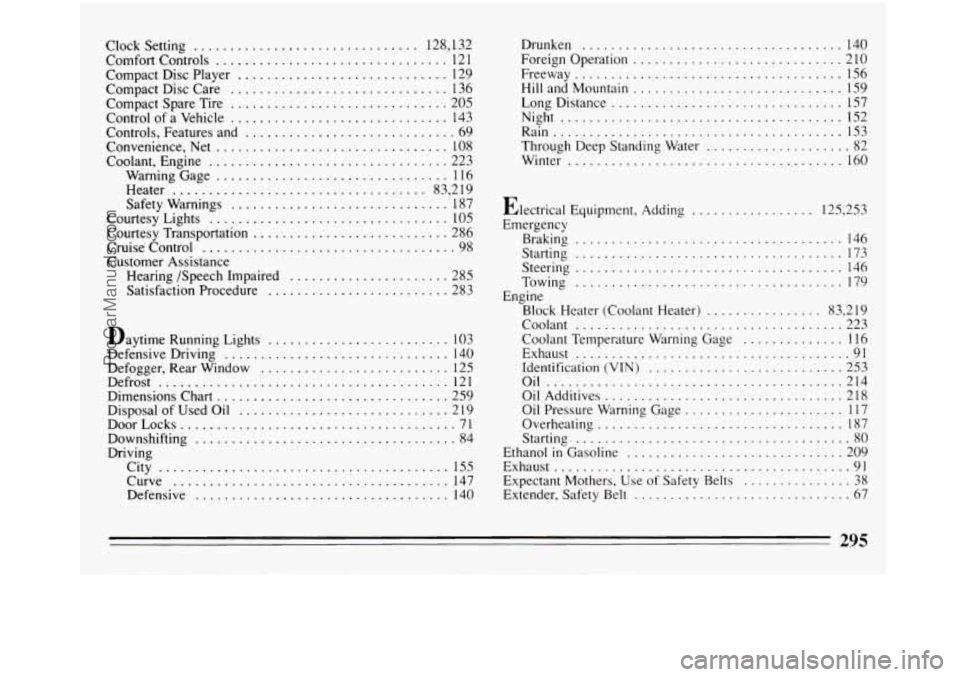
Clock Setting ............................... 128. 132
Comfort Controls
................................ 12 1
Compact Disc Player ............................. 129
Compact Disc Care
.............................. 136
Compact Spare Tire
.............................. 205
Control
of a Vehicle .............................. 143
Controls. Features and
............................. 69
Convenience. Net
................................ 108
Coolant. Engine
................................. 223
WarningGage
................................ 116
Heater
................................... 83. 2 19
Safety Warnings .............................. 187
Courtesy Lights
................................. 105
Courtesy Transportation
........................... 286
Cruise Control
................................... 98
Customer Assistance Hearing /Speech Impaired
...................... 285
Satisfaction Procedure
......................... 283
Daytime Running Lights
......................... 103
Defensive Driving
............................... 140
Defogger. Rear Window
.......................... 125
Defrost
........................................ 121
Dimensions Chart
................................ 259
Disposal of Used Oil
............................. 2 19
DoorLocks
...................................... 71
Downshifting
.................................... 84
Driving
City
........................................ 155
Curve
...................................... 147
Defensive
................................... 140 Drunken
.................................... 140
Foreign Operation
............................. 210 . Freeway ..................................... 156
Hill and Mountain
............................. 159
LongDistance
................................ 157
Night
....................................... 152
Rain
........................................ 153
Through Deep Standing Water
.................... 82
Winter
...................................... 160
Electrical Equipment. Adding
................. 125. 253
Emergency Braking
..................................... 146
Starting
..................................... 173
Towing
..................................... 179
Steering
..................................... 146
Engine Block Heater (Coolant Heater)
................ 83, 219
Coolant
..................................... 223
Coolant Temperature Warning Gage
.............. 116
Exhaust
...................................... 91
Identification
(VIN) ........................... 253
Oil
......................................... 214
Oil Additives
................................. 218
Oil Pressure Warning Gage
...................... 117
Overheating
.................................. 187
Starting
....................................... 80
Ethanol in Gasoline .............................. 209
Exhaust
......................................... 91
Expectant Mothers, Use of Safety Belts
............... 38
Extender, Safety Belt
.............................. 67
295
.- . ~ .. ...
ProCarManuals.com
Page 300 of 308
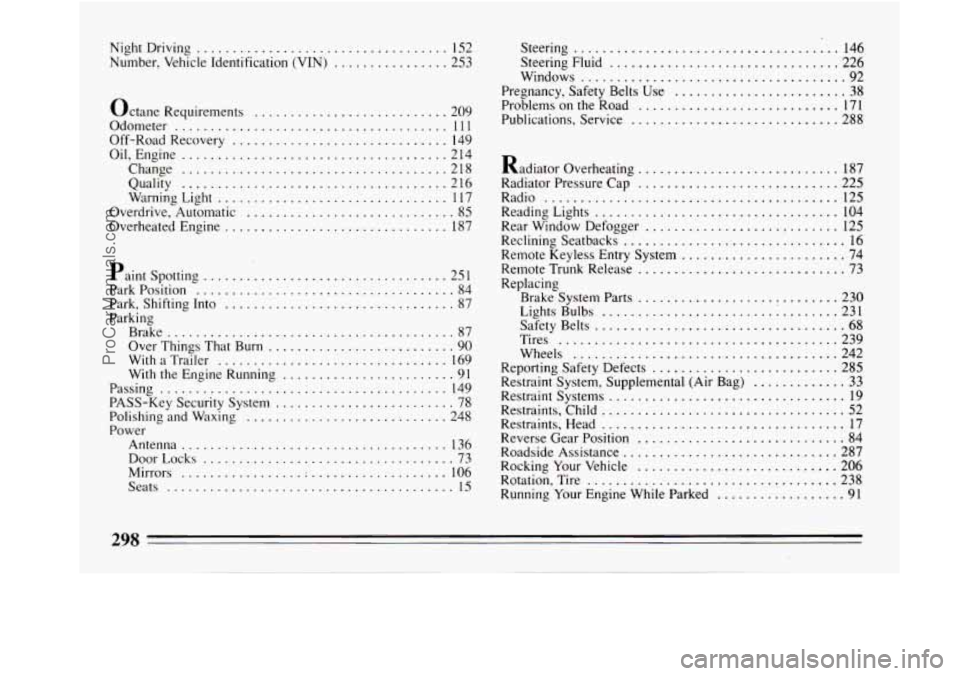
NightDriving ................................... 152
Number. Vehicle Identification (VIN)
................ 253
Octane Requirements
........................... 209
Odometer
...................................... 1 11
Oil. Engine ..................................... 214
Off-Road Recovery
.............................. 149
Change
..................................... 218
Quality
..................................... 2 16
Warning Light
................................ 117
Overheated Engine
............................... 187
Overdrive. Automatic
............................. 85
Paint Spotting
.................................. 251
Park Position
.................................... 84
Parking Park. Shifting Into
................................ 87
Over Things That Burn
.......................... 90
With the Engine Running ........................ 91
Passing
........................................ 14 9
PASS-Key Security System ......................... 78
Polishing and Waxing
............................ 248
Antenna
..................................... 136
DoorLocks
................................... 73
Mirrors
..................................... 106
Seats
........................................ 15
Brake ........................................ 87
With a Trailer
................................ 169
Power Steering
..................................... 146
Steering Fluid
................................ 226
Windows
..................................... 92
Pregnancy. Safety Belts Use ........................ 38
Problems on the Road ............................ 171
Publications. Service
............................. 288
Radiator Overheating
............................ 187
Radiator Pressure Cap
............................ 225
Radio
......................................... 125
Reading Lights
.................................. 104
Rear Window Defogger
................... ! ....... 125
Reclining Seatbacks
............................... 16
Remote Keyless Entry System ....................... 74
Remote Trunk Release
............................. 73
Replacing Brake System Parts
............................ 230
Lights Bulbs
........................ 1 ........ 231
Safety Belts
................................... 68
Tires
....................................... 239
Wheels
..................................... 242
Reporting Safety Defects
.......................... 285
Restraint System. Supplemental (Air Bag)
............. 33
Restraint Systems
................................. 19
Restraints. Child
.................................. 52
Restraints. Head
.................................. 17
Reverse Gear Position
............................. 84
Roadside Assistance
.............................. 287
Rocking Your Vehicle
............................ 206
Rotation. Tire
................................... 238
Running Your Engine While Parked
.................. 91
298
ProCarManuals.com